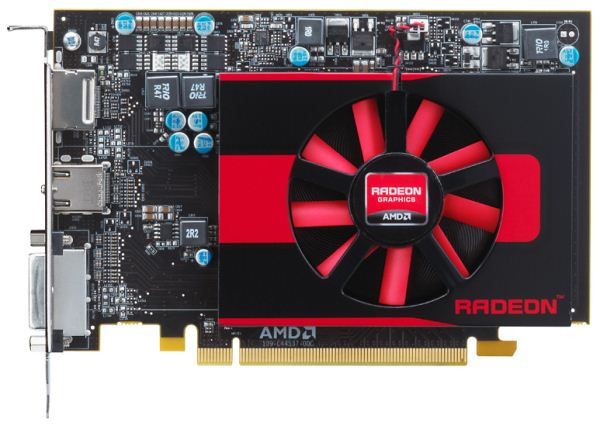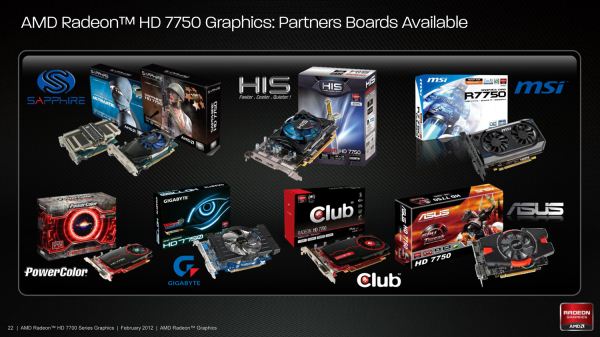AMD Radeon HD 7750 & Radeon HD 7770 GHz Edition Review: Evading The Price/Performance Curve
by Ryan Smith & Ganesh T S on February 15, 2012 12:01 AM EST- Posted in
- GPUs
- AMD
- HTPC
- GCN
- Radeon HD 7000
Meet the Radeon HD 7750
We’ll kick things off as always with a look at the cards themselves, starting with the Radeon HD 7750. As we alluded to before, this is the de-facto replacement for the Radeon HD 6670, and you only have to take one look at the card to understand why.
AMD’s reference design for the 7750 is virtually identical to the full-profile 6670 or the FirePro V4900, which should come as no surprise given that all of these cards are or were AMD’s top sub-75W cards in their respective markets. As a result, like those cards the reference 7750 is a full-profile card featuring a single-wide active cooler.
As the 7750 is AMD’s cheapest Southern Islands card, you won’t find much else on the card to speak of. As a sub-75W card it doesn’t need external power, and cementing its position as the replacement for the 6670 there isn’t a CrossFire connector on the card. For RAM the card uses 4 256MB Hynix GDDR5 RAM chips, which are rated for 5GHz. The card is 6.57” long overall, the same length as the 6670.

Meanwhile for display connectivity, AMD is once again using the same configuration as we’ve seen in their other full-profile mainstream cards. This means 1 DL-DVI port, 1 HDMI port, and interestingly enough 1 full size DisplayPort. The latter is particularly odd, as the rest of the Southern Islands lineup is exclusively miniDP and in the last year miniDP has become the de-facto port for source devices. AMD has told us that there’s no specific reason that they’re using a full size DisplayPort here, and we believe it’s largely being done out of maintaining consistency with previous products. With that said we’d rather see miniDP here – even if it’s just 1 port instead of 2 – so that it’s consistent with the rest of the 7000 series.
Finally, as is customary for a midrange product launch, everyone is doing semi-custom cards right off the bat. Everyone will be using AMD’s PCB for now, while none of the 7750 cards in the press materials sent to us will be using AMD’s cooler. Instead we’ll see a range of designs, from similar side-wide designs to the more common double-wide designs, and even a passively cooled design from Sapphire. Much like the 6670 the HTPC use case for the 7750 is rather obvious, so we suspect that we’ll see more passive and perhaps even some low-profile cards in the future.


















155 Comments
View All Comments
tipoo - Wednesday, February 15, 2012 - link
I probably won't be enticed into a video card upgrade until the next generation of Microsoft and Sony consoles are out. In the land of console ports, even a 6770 can run nearly everything comfortably at most common monitor resolutions.Movieman420 - Wednesday, February 15, 2012 - link
I have an OCd C2D Wolfdale running the 4850 and I also agree that the 4850 will go down as one of the best bang for the buck cards ever.My current i5/Z68 rig is running what I think will be considered another BBFTB card...the 6850...the dual fan Gigabyte 685OC in my case.
The 5770/6770/7770 are a fantastic line of mid-range cards...esp OCd but for a few $$ more an OCd 6850 still holds it's own quite well, there's no real counter for a 256bit vs 128bit memory bus. A big hats off tho to the 7770's high res numbers...pretty damn sweet, but I don't need uber res for a 23.5 inch monitor...ofc I'm not a hard core gamer either.
cjs150 - Wednesday, February 15, 2012 - link
7750 seems perfect for an HTPC. But to put it into context, IGPs should be using the 7750 as the benchmark for what to aim for. Can see this becoming completely obselete very soon once products based on Raspberry pi or Cu Box get released and match (the very impressive) picture quality of the 7750. In mean time get a low profile passive cooled version out and it will be perfect.As for the 7770 I simply see no purpose for it at all. NVidia 560 is only marginally more expensive and beats it completely. 7770 seems to me to be a complete waste of stock
Shadowmaster625 - Wednesday, February 15, 2012 - link
So the 7770 should be at $109, and that forces the 7750 down to $89 or less. The die sizes on these chips are a lot smaller than their competition so I dont see what AMD is thinking. Inflation? lol.Shadowmaster625 - Wednesday, February 15, 2012 - link
Why would a 7750 consumer 3 watts less than a 7770 during the "long idle" state. That really makes no sense. During that state there shouldnt be any difference at all between the two cards.tipoo - Wednesday, February 15, 2012 - link
It has over 100 more stream processors? 3W is pretty minuscule.akbo - Wednesday, February 15, 2012 - link
They are using a gorram 1200W PSU and those have s*** efficiency at 10% load. 3 watts means that it may pull about 1 watt more on-chip.KompuKare - Wednesday, February 15, 2012 - link
Which begs a simple question that has been bothering me with Anandtech GPU reviews for a while: how come they don't measure the wattage for the cards rather the whole system. Ok, it needs a custom PCI-E riser board and a multimeter but other sites (like techpowerup.com or this French site (can't think of it ATM) where the place I first saw that method used) manage it.Or at a minimum why is there no IGPU (Intel 3000) power usage in the review to act as a baseline?
Death666Angel - Wednesday, February 15, 2012 - link
I'm kinda disappointed by the 77xx launch. I'd have hoped for some €150 - €200 cards, consequently performing better than the 6870. Maybe the 78xx will be better. I really hope nVidia comes around with good cards, that way the consumer won't get ripped off. Although I also hope that AMD makes some money in the mean time.geniekid - Wednesday, February 15, 2012 - link
I just want to reiterate how much I appreciate the games you've chosen for your benchmarks. It's a very diverse set of games and covers a lot of the non-FPS genres that other review sites tend to leave out.